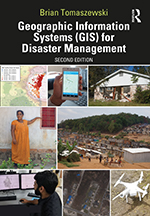
|
Chapter 3: Geographic Information Systems |
This is the companion website for Chapter 3: Geographic Information Systems from the book Geographic Information Systems (GIS) for Disaster Management (second edition). This page contains links to any technical video walk throughs contained in the chapters, slides for the chapters, chapter test questions, and other additional materials.
Chapter Abstract
The chapter provides an overview of core GIS conceptual and technical topics that are foundations in subsequent chapters. Discussion is first made as to what a GIS is and what it can and cannot do. Topics include spatial data and asset management, data querying and table joining, spatial analysis, GIS programming and application programming interfaces (APIs), spatial modeling, cartography, visualization, and map production, geocoding, animation and 3D, mobile GIS, field data collection, and GIS Limitations. GIS data models (raster, vector, Triangulated Irregular Networks (TIN), and networks) along with GIS metadata are also discussed. A survey of specific commercial (Esri ArcGIS Pro), Open Source (QGIS), and other GIS technologies (Google) is also made to inform the reader of specific GIS technology options available for desktop, web, and mobile platforms. The chapter concludes with ideas on open data for disaster management, sources of free GIS data, and ideas on how to choose the right GIS technology for disaster management in terms of getting started with GIS and building an open source geospatial stack. The chapter concludes with a three technical exercises: (1) table joining in GIS, (2) Python Scripting in ArcGIS Pro, and (3) Python Scripting in QGIS.
Chapter Objectives: Upon chapter completion, readers should be able to:
- understand the components of GIS;
- understand the concept of layers in GIS;
- be familiar with common GIS functions and how they relate to disaster management;
- be familiar with common GIS data-storage formats;
- understand some of the limitations of GIS;
- understand what GIS metadata is and why it is important;
- identify and discern a variety of specific GIS technologies that are relevant to disaster management.
Follow these links to access Chapter 3: Geographic Information Systems materials:
- Chapter 3 Slides (.pptx, 11.07 mb)
- Exercise 3-1: Basic Table Join technical video walkthrough
- Chapter 3 Test Bank (.docx, 19 kb) | Chapter 3 Test Bank (.pdf, 142 kb)
For information on this chapter, purchase the book from Routledge Press »